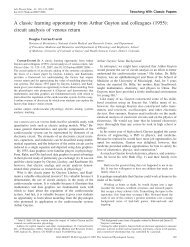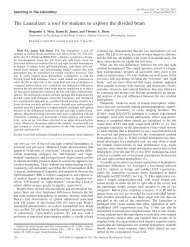construction of a model demonstrating neural pathways and reflex arcs
construction of a model demonstrating neural pathways and reflex arcs
construction of a model demonstrating neural pathways and reflex arcs
You also want an ePaper? Increase the reach of your titles
YUMPU automatically turns print PDFs into web optimized ePapers that Google loves.
INNOVATIONS A N D I D E A S<br />
FIG. 20.<br />
This figure should be used in conjunction with directions for assembling the monosynaptic <strong>reflex</strong>/patellar tendon<br />
<strong>reflex</strong>. Battery unit represents the stimulus/receptor. Wires labeled by color or tape follow the path <strong>of</strong> the sensory<br />
neurons to the spinal cord. Knife switch <strong>and</strong> lamp correspond to the synaptic junction between the sensory <strong>and</strong><br />
motor neurons. Wires labeled by color or tape follow the path <strong>of</strong> the motor neuron to the muscle effector. In this<br />
<strong>model</strong> the muscle effector is represented by a motor.<br />
neuron. The chemical neurotransmitters have also<br />
been converted into an electrical form. By pushing<br />
down the lever, you have decided that enough electri-<br />
cal signal has accumulated at the axon hillock for an<br />
action potential to be created.<br />
D. Now the action potential, as represented by the<br />
electrical current in the <strong>model</strong>, travels through the<br />
wires labeled MOTOR NEURON. At the end <strong>of</strong> the<br />
wire (the end <strong>of</strong> the axon), the information turns on<br />
the motor. The motor represents the resulting action<br />
caused by the stimulus (tapping <strong>of</strong> the patellar ten-<br />
don). The quadriceps muscle contracts. This, along<br />
with help from the polysynaptic component <strong>of</strong> the<br />
patellar tendon <strong>reflex</strong>, causes the leg to kick out.<br />
QUESTIONS. I) Discuss why the lamp <strong>and</strong> switch were<br />
together as a unit when you received them. Think<br />
about the difference between a synapse <strong>and</strong> synaptic<br />
transmission when developing your answer.<br />
2) Is the cerebral cortex involved in a monosynaptic<br />
<strong>reflex</strong> arc? Explain your answer thoroughly.<br />
3) Describe the polysynaptic component <strong>of</strong> this<br />
monosynaptic <strong>reflex</strong>.<br />
ANSWERS (PATEUAR TENDON REFLEX). 1) Recall that a<br />
synapse is an anatomic structure that includes the<br />
junction <strong>of</strong> two neurons <strong>and</strong> the space between them.<br />
Synaptic transmission is an event that involves the<br />
VOLUME 16 : NUMBER 1 - ADVANCES IN PHYSIOLOGY EDUCATION - DECEMBER 1996<br />
s37









